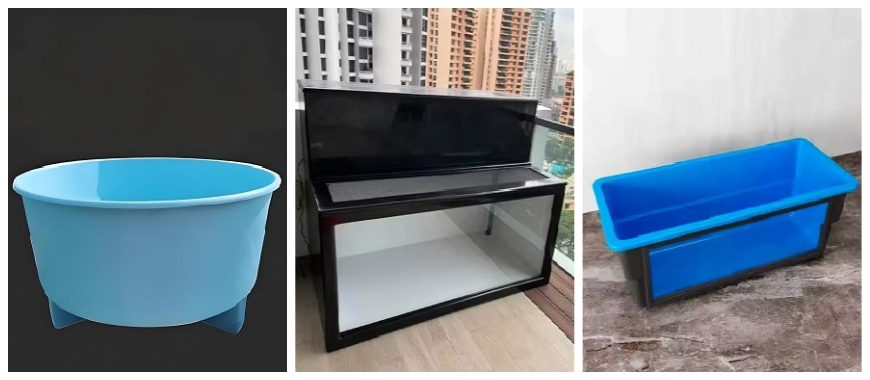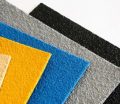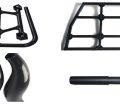
The Key of Building an Aluminum Frame Fiberglass Boat
An aluminum frame fiberglass boat combines the lightweight strength of aluminum with the smooth, durable surface of fiberglass, creating a vessel that excels in both performance and resilience. This hybrid design is ideal for a range of applications, from recreational boating to fishing, and offers excellent longevity with reduced maintenance. The process of bonding aluminum to fiberglass, however, requires careful consideration of materials and techniques to ensure structural integrity and long-term performance.
Will Polyester Resin Stick to Aluminum?
Bonding Capabilities of Polyester Resin
Polyester resin is widely used in fiberglass construction due to its affordability and ease of use. However, its bonding capabilities with aluminum are limited. While polyester resin adheres well to porous surfaces, aluminum’s smooth and non-porous nature makes it challenging to achieve a strong bond without additional preparation.
Limitations of Polyester Resin
One major limitation is the resin’s susceptibility to peeling or detaching from aluminum over time, especially when exposed to moisture or temperature fluctuations. This weakness can compromise the integrity of an aluminum frame fiberglass boat, requiring alternative bonding methods to ensure durability.
Alternatives to Polyester Resin
Epoxy resin is a preferred alternative for bonding aluminum to fiberglass. Epoxy provides superior adhesion, strength, and water resistance, making it better suited for marine applications. Combining proper surface preparation techniques, such as sanding and priming the aluminum, with epoxy ensures a reliable bond.
Environmental Impact and Moisture Exposure
When selecting a resin, it’s important to consider environmental factors. Polyester resin may degrade under prolonged exposure to saltwater or UV rays, whereas epoxy is more resistant to these elements. For aluminum frame fiberglass boats, using materials that withstand marine environments is essential for long-term performance.
Durability Considerations
The durability of the bond between aluminum and fiberglass determines the boat’s structural integrity. While polyester resin offers a quick solution, its limitations necessitate the use of alternative adhesives or methods for a robust and lasting bond.
Choosing the Right Bonding Technique for Aluminum Frame Fiberglass Boats
Importance of Proper Bonding
The bond between aluminum and fiberglass is critical to the structural integrity and longevity of an aluminum frame fiberglass boat. Selecting the right adhesive and preparation methods ensures the boat remains durable and reliable under various conditions.
Summary of Best Adhesive Options
While polyester resin is a common choice in fiberglass construction, it is not the best option for bonding to aluminum. Alternatives like epoxy resin and 3M 5200 provide superior adhesion, durability, and resistance to environmental factors. These materials, combined with proper surface preparation, are essential for achieving a secure bond.
Tips for Successful Bonding
To ensure a strong and lasting bond, always prepare the aluminum surface by cleaning, sanding, and priming it. Use adhesives specifically designed for marine applications, and follow the manufacturer’s instructions for curing times and conditions.
Final Thoughts on Material Compatibility
The compatibility of aluminum and fiberglass depends on the adhesive used and the conditions under which the bond is formed. By understanding the properties of each material and choosing the right bonding technique, boat owners and builders can create aluminum frame fiberglass boats that are both durable and high-performing. Investing in quality materials and techniques ensures the boat’s reliability and functionality for years to come.
3M 5200: A Powerful Solution for Bonding Fiberglass to Aluminum
Introduction to 3M 5200
3M 5200 is a popular adhesive and sealant widely used in marine construction and repair. Known for its high strength and flexibility, it is an ideal choice for bonding fiberglass to aluminum in an aluminum frame fiberglass boat.
Why 3M 5200 Is Favored for Boat Construction
The adhesive properties of 3M 5200 allow it to create a watertight seal between aluminum and fiberglass, preventing moisture intrusion and corrosion. Its resistance to saltwater and UV exposure makes it particularly suited for marine environments.
How It Works
3M 5200 is a polyurethane adhesive that chemically reacts with moisture to form a durable and flexible bond. This flexibility is crucial for accommodating the expansion and contraction of aluminum and fiberglass, reducing the risk of stress cracks or bond failure.
Durability and Longevity
The durability of 3M 5200 ensures that bonded joints remain secure for years. Once fully cured, it provides exceptional tensile strength, capable of withstanding the dynamic stresses experienced by boats in rough waters.
Ideal Use Cases in Aluminum Frame Fiberglass Boats
For aluminum frame fiberglass boats, 3M 5200 is often used to bond structural components, seal joints, and provide added strength to high-stress areas. Its versatility and reliability make it a preferred adhesive for both construction and repairs.
Finding the Perfect Fiberglass 2 Seater Bass Boat for Sale
The Key of Building an Aluminum Frame Fiberglass Boat
An aluminum frame fiberglass boat combines two versatile materials to create a structure that is lightweight, durable, and well-suited for various marine applications. This type of boat is especially popular due to its strength-to-weight ratio, corrosion resistance, and adaptability to both fresh and saltwater environments. By combining aluminum’s structural capabilities with fiberglass’s smooth finish and flexibility, these boats provide a high-performance solution for recreational, fishing, and commercial needs.
Will Fiberglass Stick to Aluminum?
Challenges of Bonding Fiberglass to Aluminum
Fiberglass does not naturally adhere to aluminum due to the differences in their surface properties. Aluminum is smooth and non-porous, which makes it difficult for fiberglass to bond without additional preparation. Furthermore, aluminum forms an oxide layer when exposed to air, creating another barrier to effective adhesion.
Factors Affecting Adhesion
Several factors influence the ability of fiberglass to stick to aluminum, including surface preparation, the type of adhesive or resin used, and environmental conditions during application. Proper preparation, such as sanding or etching the aluminum surface, is crucial to ensure a strong bond. Primers designed for aluminum can also improve adhesion.
Using Special Adhesives and Primers
While fiberglass does not naturally stick to aluminum, using the right adhesive and primer can overcome this limitation. Epoxy resins are the most effective choice for bonding fiberglass to aluminum, as they offer strong adhesion and resistance to environmental factors. Primers designed specifically for aluminum create a bondable surface for the resin, ensuring a durable connection between the materials.
Long-Term Durability
The durability of the bond between fiberglass and aluminum depends on the quality of the adhesive and the thoroughness of surface preparation. When done correctly, the bond can withstand marine conditions, providing a long-lasting solution for repairs or structural enhancements in an aluminum frame fiberglass boat.
Can You Use Fiberglass on an Aluminum Boat?
Applications of Fiberglass on Aluminum Boats
Fiberglass can be applied to aluminum boats for repairs, reinforcement, or customization. It is often used to reinforce the hull, create non-slip decking, or repair damaged areas. This versatility makes it a valuable material for enhancing the performance and longevity of aluminum boats.
Suitability for Different Parts of the Boat
Fiberglass is suitable for various parts of an aluminum boat, including the hull, decking, and interior structures. For the hull, fiberglass can provide additional strength and impact resistance. On the deck, it offers a smooth, slip-resistant surface that is easy to maintain. For interior areas, fiberglass can be molded to create custom compartments or storage solutions.
Advantages Over Traditional Materials
Using fiberglass in an aluminum frame fiberglass boat has several advantages over traditional materials like wood or steel. Fiberglass is lightweight, corrosion-resistant, and easy to shape, making it ideal for repairs and modifications. Additionally, it requires less maintenance than wood and offers better long-term performance in marine environments.
Considerations for Application
When applying fiberglass to aluminum, it is important to use compatible adhesives and techniques. Proper preparation of the aluminum surface is essential to ensure adhesion. Environmental conditions, such as temperature and humidity, should also be controlled to achieve the best results.
Examples of Success
Many boat owners and builders have successfully used fiberglass on aluminum boats to enhance durability and aesthetics. For instance, repairing a damaged hull with fiberglass not only restores its strength but also provides a seamless finish that blends with the boat’s original design.
Why Fiberglass Bass Boat Bumper Is Essential
Benefits of an Aluminum Frame Fiberglass Boat
Lightweight and Strong
An aluminum frame fiberglass boat offers the perfect balance of strength and weight. The aluminum frame provides a sturdy foundation, while the fiberglass adds a lightweight, smooth finish that enhances the boat’s performance.
Corrosion Resistance
Both aluminum and fiberglass are resistant to corrosion, making this combination ideal for marine environments. Aluminum’s natural resistance to rust, combined with fiberglass’s water-resistant properties, ensures long-lasting durability.
Customizability
Fiberglass is highly versatile and can be molded into various shapes and designs. This allows for custom features, such as storage compartments, seating arrangements, or unique hull designs, tailored to the owner’s needs.
Reduced Maintenance
An aluminum frame fiberglass boat requires minimal maintenance compared to boats made from wood or steel. Aluminum does not rust, and fiberglass is easy to clean, reducing the time and cost associated with upkeep.
Aesthetic Appeal
The smooth, glossy finish of fiberglass enhances the boat’s appearance, while the aluminum frame ensures structural integrity. This combination creates a visually appealing and functional vessel suitable for a variety of applications.
An aluminum frame fiberglass boat is a practical and versatile choice for boat owners seeking durability, performance, and customization options. By understanding the best materials, adhesives, and techniques for construction and repair, you can ensure your boat meets your specific needs and withstands the challenges of marine environments.
Best Adhesive to Bond Fiberglass to Metal
Epoxy Adhesives
Epoxy is widely regarded as the best adhesive for bonding fiberglass to aluminum in an aluminum frame fiberglass boat. It provides excellent adhesion, water resistance, and durability. Epoxy is versatile and can be used for both structural and cosmetic applications, making it the top choice for marine projects.
Polyurethane Adhesives
Polyurethane adhesives are another effective option for bonding fiberglass to aluminum. They offer flexibility and strong adhesion, accommodating the expansion and contraction of materials in varying temperatures. Polyurethane is also resistant to UV rays and moisture, ensuring long-term performance.
Polyester Resin
While polyester resin is commonly used in fiberglass construction, it is less effective for bonding to aluminum. Its adhesion properties are weaker compared to epoxy, and it is more prone to delamination over time. Polyester resin may still be used for non-structural applications where high-strength bonding is not required.
Choosing the Right Adhesive
Selecting the best adhesive depends on the application and environmental conditions. For high-stress areas, such as the hull or frame, epoxy adhesives are recommended due to their superior strength. For flexible joints or areas exposed to extreme conditions, polyurethane adhesives are ideal.
Tips for Successful Bonding
To achieve a strong and durable bond, always prepare the aluminum surface by cleaning, sanding, and priming it. Follow the manufacturer’s instructions for mixing and applying the adhesive, and allow adequate curing time before subjecting the bond to stress. Testing a small area before full application can help ensure compatibility and effectiveness.
How to Choose the Best Fiberglass Bass Boat Consoles
FAQs about Aluminum Frame Fiberglass Boat
Both aluminum and fiberglass have their advantages, and the better material for a boat largely depends on the type of boating activity, the environment, and the desired performance characteristics. Aluminum boats are generally known for their strength, durability, and resistance to damage, especially in rugged conditions like rocky shorelines. They are typically lighter than fiberglass boats and offer superior resistance to punctures and cracks. However, aluminum boats tend to be noisier on the water and may require more frequent maintenance to prevent corrosion, especially in saltwater environments.
On the other hand, fiberglass boats are more versatile in design, offering greater customization in shape and aesthetics. They are generally smoother on the water, quieter, and provide better fuel efficiency. Fiberglass also tends to last longer without the same level of maintenance as aluminum, though it can be prone to cracking or damage from impact. If you are looking for a boat with better handling and smoother performance, fiberglass might be the better option. If you prioritize durability and low maintenance, especially in tough environments, aluminum may be the way to go.
While aluminum boats offer numerous benefits, there are some drawbacks that potential buyers should consider. One of the primary downsides is the susceptibility of aluminum to corrosion, particularly in saltwater environments. Without proper maintenance, including applying anti-corrosion treatments and regularly cleaning the boat, the aluminum hull can corrode over time, affecting its longevity. Additionally, while aluminum boats are generally lighter, they can be noisier compared to fiberglass boats. The sound of water hitting the hull can be amplified, which may be a drawback for those seeking a quieter, more peaceful boating experience.
Another downside is the rigidity of aluminum. Although it is incredibly strong, it does not absorb impact as well as fiberglass. This means that aluminum boats can be more prone to dents or damage from hard knocks or collisions with underwater obstacles. Lastly, aluminum boats are often more expensive than fiberglass boats, especially for models with additional features or advanced design.
Yes, it is possible to patch an aluminum boat with fiberglass, but there are certain considerations to keep in mind. Fiberglass is often used to repair fiberglass boats, and the same principle can apply to aluminum boats, especially for minor repairs or when fiberglass is the most readily available material. To patch an aluminum boat with fiberglass, the aluminum surface must be properly cleaned and prepped to ensure good adhesion. This may involve sanding the area, cleaning it with a solvent, and ensuring that the surface is free from corrosion or oils.
However, while fiberglass can provide a temporary or supplementary solution for patching, it’s not always the most effective long-term fix for aluminum boats. Fiberglass repairs can add some flexibility to the structure, but they might not fully address the unique needs of aluminum, such as maintaining the metal’s strength and durability. For major repairs, especially those involving structural integrity, it’s often better to use aluminum welding or other methods designed specifically for metal. When using fiberglass patches, it’s important to regularly check the integrity of the repair to ensure it’s still holding up in the demanding marine environment.

As the editor of GangLong Fiberglass, I have years of experience and in-depth research, focusing on cable tray products, fiberglass solutions, and grille systems. I incorporate years of industry insights and practical experience into every content, committed to promoting the progress of the industry. At GangLong Fiberglass, my commitment is reflected in every product, from innovative cable trays to durable fiberglass solutions and sturdy grille systems. As an authoritative voice in the industry, my goal is to provide valuable information to professionals and businesses and promote forward-looking solutions.


